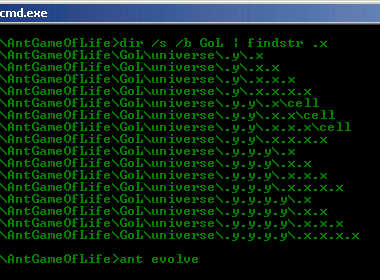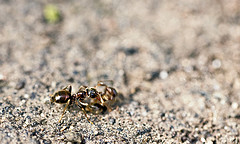apply_rules which determined if a given cell would be reborn, live on or die. This part is about applying the rules of the game to whole generations. Here are the test cases to identify the next generation.<target name="all-test-targets" description="run all test targets">
...
<antcall target="test-next-gen-living-with-no-neighbours-dies" />
<antcall target="test-next-gen-empty-with-three-neighbours-comes-alive" />
</target>
<target name="test-next-gen-empty-with-three-neighbours-comes-alive">
<make-tmp-dir />
<antcall target="create_3x3_grid" />
<touch file="${test.temp_dir}/.y/.x.x/cell" />
<touch file="${test.temp_dir}/.y.y/.x/cell" />
<touch file="${test.temp_dir}/.y.y/.x.x/cell" />
<antcall target="next_generation">
<param name="p_cell_location" value="${test.temp_dir}/.y/.x" />
</antcall>
<assert-file-exists file="${test.temp_dir}/.y/.x/next" />
</target>
...
<property name="cell.marker_will_live" value="next" />
<target name="next_generation" depends="apply_rules" if="cell.will_live"
description="creates a 'next' file if a cell in the given location
'p_cell_location' will be in the next generation.">
<touch file="${p_cell_location}/${cell.marker_will_live}" />
</target>The target next_generation marks a cell which will live (on) by creating an empty marker file inside its folder. The Universe is (maybe) infinite
The Universe is (maybe) infiniteIn the previous part I defined the universe as a folder structure containing all cells.
universe/
.y/
.x/
.x.x/
...
.y.y/
.x/
.x.x/
...
.y.y.y/
...The universe is 2-dimensional and has a certain size. To support universes of arbitrary size I started testing for 2 times 2 grids,<import file="lib/asserts.xml" />
<import file="universe-build.xml" />
<target name="test-create-empty-2x2-universe">
<make-tmp-dir />
<antcall target="create_universe">
<param name="p_universe_location" value="${test.temp_dir}" />
<param name="p_universe_size" value="2" />
</antcall>
<assert-file-exists file="${test.temp_dir}/universe/.y/.x" />
<assert-file-exists file="${test.temp_dir}/universe/.y/.x.x" />
<assert-file-exists file="${test.temp_dir}/universe/.y.y/.x" />
<assert-file-exists file="${test.temp_dir}/universe/.y.y/.x.x" />
</target>and then for 3 times 3, 4 times 4 and so on. The creation of each universe was straight forward, but there was a lot of duplication in the different creation targets. Creating an 1 by 1 universe was trivial and adding dimensions step by step seemed a good way to remove duplication.<target name="create_universe_3" depends="create_universe_2">
<antcall target="universe_add_dimension" />
</target>
<target name="create_universe_2" depends="create_universe_1">
<antcall target="universe_add_dimension" />
</target>
<target name="create_universe_1" if="universe.location">
<mkdir dir="${universe.location}/.y/.x" />
</target>Increasing the grid's first dimension, the y- or row-dimension, of an existing grid is done by adding a new row folder .y.y.y. Adding the second, x- or column-dimension means adding another column .x.x.x to each row folder .y, .y.y and so on. In Ant this can be done using copy and regexpmapper adding another .x or, respectively .y to the matched group of .xs or .ys.<macrodef name="universe_add_row"
description="copies the row folders and renames them as additional row.">
<sequential>
<copy todir="${universe.location}" includeEmptyDirs="true" overwrite="false">
<fileset dir="${universe.location}" includes="${universe.struct}" />
<regexpmapper from="^(.*\.y)(/.*\.x)$$" to="\1.y/\2" handledirsep="yes" />
</copy>
</sequential>
</macrodef>
<macrodef name="universe_add_column"
description="copies the column folders and renames them as additional column.">
<sequential>
<copy todir="${universe.location}" includeEmptyDirs="true" overwrite="false">
<fileset dir="${universe.location}" includes="${universe.struct}" />
<regexpmapper from="^(.*\.x)$$" to="\1.x" />
</copy>
</sequential>
</macrodef>
<target name="universe_add_dimension" if="universe.location"
description="adds one dimension in column- and row-folders.">
<universe_add_column />
<universe_add_row />
</target>That removed all duplicated mkdir commands in the creation targets. Still I was not happy with that solution because I needed to provide a target <target name="create_universe_N"> and all previous targets for each dimension N I wanted to support. I spent some time trying to resolve this but failed. Ant does not provide any kind of loop construct and does not allow for recursion when calling targets. (Using Ant-Contrib's extensions like For was out of the question because I wanted to write idiomatic Ant which is rather declarative than imperative.) So the current solution only supports grids up to a fixed dimension. Generations
GenerationsAfter creating universes of (almost) arbitrary size and seeding them I had to iterate all cells (folders) to update the whole universe at once. I did not need any new code, just a way to execute the
cell-build.xml script inside each cell (folder) of the universe. After creating a (sort of integration) test for the desired functionality, I added a final target to the cell-build.xml that initialised the cell's location (p_cell_location) with the current build script's directory (${basedir}).<target name="next_gen_for_basedir_cell"
description="creates a 'next' file if the cell in the
basedir will be in the next generation.">
<antcall target="next_generation">
<param name="p_cell_location" value="${basedir}" />
</antcall>
</target>Then, after some experiments, I was able to use Ant's subant task to execute the logic for each cell inside each cell's folder.<property name="universe.base_dir" value="universe" />
<property name="universe.struct" value="*/*" />
<property name="cell.build_file" value="cell-build.xml" />
<target name="next_generation" if="p_universe_location"
description="applies the rules for next generation for each cell of
the universe folder structure in location 'p_universe_location'.">
<subant genericantfile="${cell.build_file}">
<dirset dir="${p_universe_location}/${universe.base_dir}"
includes="${universe.struct}" />
</subant>
</target>Including */* in the dirset selects only cells (the leaf directories) and no intermediate ones. I have never used subant before but I am still amazed by its power. It is a great tool to get rid of duplication or complicated series of targets. Even using an Ant extension with its loop would not produce such a concise way of iterating all cells.The above code creates empty marker files (
next) for all cells that will be alive in the next generation. All that is left is to delete the old generation (${cell.marker_alive}) and rename the new generation (${cell.marker_will_live}) to the current one.<target name="evolve" depends="next_generation" if="p_universe_location"
description="evolves the whole universe folder structure in location 'p_universe_location'.">
<property name="universe.location" location="${p_universe_location}/${universe.base_dir}" />
<delete dir="${universe.location}" includes="${universe.struct}/${cell.marker_alive}" />
<copy todir="${universe.location}" includeEmptyDirs="false" overwrite="false">
<fileset dir="${universe.location}" includes="${universe.struct}/${cell.marker_will_live}" />
<regexpmapper from="^(.*)${cell.marker_will_live}$$" to="\1${cell.marker_alive}" />
</copy>
<delete dir="${universe.location}" includes="${universe.struct}/${cell.marker_will_live}" />
</target>The final test is more an acceptance test than a unit test because it exercises all rules and functionality by evolving a whole universe which has been seeded a blinker.<target name="test-evolve-updates-all-cells">
<make-tmp-dir />
<antcall target="create_universe">
<param name="p_universe_location" value="${test.temp_dir}" />
<param name="p_universe_size" value="3" />
</antcall>
<!-- seed blinker -->
<universe_seed_cell location="${test.temp_dir}" row=".y.y" column=".x" />
<universe_seed_cell location="${test.temp_dir}" row=".y.y" column=".x.x" />
<universe_seed_cell location="${test.temp_dir}" row=".y.y" column=".x.x.x" />
<!-- run GoL -->
<antcall target="evolve">
<param name="p_universe_location" value="${test.temp_dir}" />
</antcall>
<assert-file-does-not-exist file="${test.temp_dir}/universe/.y.y/.x/cell" />
<assert-file-does-not-exist file="${test.temp_dir}/universe/.y.y/.x.x.x/cell" />
<assert-file-exists file="${test.temp_dir}/universe/.y/.x.x/cell" />
<assert-file-exists file="${test.temp_dir}/universe/.y.y/.x.x/cell" />
<assert-file-exists file="${test.temp_dir}/universe/.y.y.y/.x.x/cell" />
</target>It works! ;-) Here is proof in form of a little animation of the Ant Game of Life in action:
















